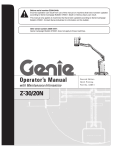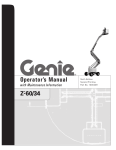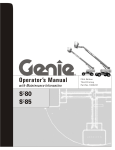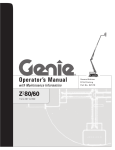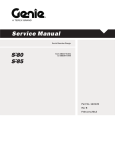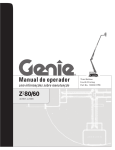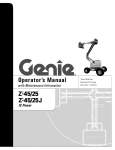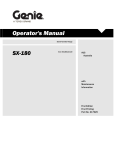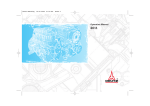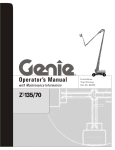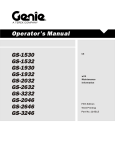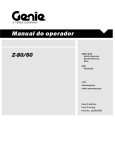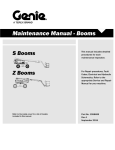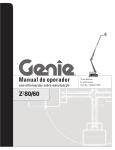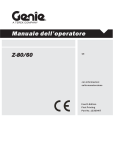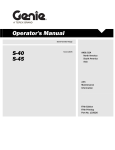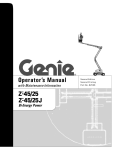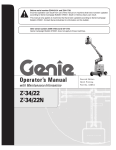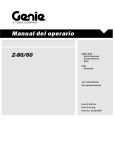Download Untitled
Transcript
Operator's Manual Fifth Edition • Third Printing Important Read, understand and obey these safety rules and operating instructions before operating this machine. Only trained and authorized personnel shall be permitted to operate this machine. This manual should be considered a permanent part of your machine and should remain with the machine at all times. If you have any questions, call Genie. Contents Page Introduction ................................................................ 1 Symbol and Hazard Pictorial Definitions ..................... 3 General Safety ........................................................... 5 Personal Safety ......................................................... 7 Work Area Safety ....................................................... 8 Legend ...................................................................... 16 Controls .................................................................... 17 Inspections ............................................................... 26 Operating Instructions ............................................... 38 Transport and Lifting Instructions .............................. 48 Maintenance ............................................................. 51 Specifications ........................................................... 54 Contact us: Copyright © 2002 by Terex Corporation Fifth Edition: Internet: www.genielift.com E-mail: [email protected] Third Printing, March 2013 "Genie" and "Z" are registered trademarks of Terex South Dakota in the U.S.A. and many other countries. Complies with EC Directive 2006/42/EC See EC Declaration of Conformity Printed on recycled paper Printed in U.S.A. Z-80/60 Part No. 133539 Fifth Edition · Third Printing Operator's Manual Introduction Owners, Users and Operators: Genie appreciates your choice of our machine for your application. Our number one priority is user safety, which is best achieved by our joint efforts. We feel that you make a major contribution to safety if you, as the equipment users and operators: Danger 1 Comply with employer, job site and governmental rules. 2 Read, understand and follow the instructions in this and other manuals supplied with this machine. 3 Use good safe work practices in a commonsense way. Failure to obey the instructions and safety rules in this manual will result in death or serious injury. Do Not Operate Unless: 4 Only have trained/certified operators, directed by informed and knowledgeable supervision, running the machine. You learn and practice the principles of safe machine operation contained in this operator's manual. If there is anything in this manual that is not clear or which you believe should be added, please contact us. 1 Avoid hazardous situations. Internet: www.genielift.com 2 Always perform a pre-operation inspection. E-mail: [email protected] 3 Always perform function tests prior to use. Know and understand the safety rules before going on to the next section. 4 Inspect the workplace. 5 Only use the machine as it was intended. You read, understand and obey the manufacturer's instructions and safety rules— safety and operator's manuals and machine decals. You read, understand and obey employer's safety rules and work site regulations. You read, understand and obey all applicable governmental regulations. You are properly trained to safely operate the machine. Part No. 133539 Z-80/60 1 Operator's Manual Fifth Edition · Third Printing Introduction Hazard Classification Intended Use Genie uses symbols, color coding and signal words to identify the following: This machine is intended to be used only to lift personnel, along with their tools and materials to an aerial work site. Safety alert symbol—used to alert you to potential personal injury hazards. Obey all safety messages that follow this symbol to avoid possible injury or death. 2 Red Indicates a hazardous situation which, if not avoided, will result in death or serious injury. Orange Indicates a hazardous situation which, if not avoided, could result in death or serious injury. Yellow Indicates a hazardous situation which, if not avoided, could result in minor or moderate injury. Blue Indicates a hazardous situation which, if not avoided, could result in property damage. Safety Sign Maintenance Replace any missing or damaged safety signs. Keep operator safety in mind at all times. Use mild soap and water to clean safety signs. Do not use solvent-based cleaners because they may damage the safety sign material. Z-80/60 Part No. 133539 Fifth Edition · Third Printing Operator's Manual Symbol and Hazard Pictorials Definitions Crush Hazard Keep away from moving parts. Burn Hazard No smoking. No flame. Stop engine. Tip-over Hazard Fall Hazard Keep off this surface. Tip-over Hazard Tip-over Hazard Read the operator’s manual. Electrocution Hazard Maintain required clearance. Crush Hazard Keep away from path of moving platform. Explosion Hazard Recovery procedure if tilt alarm sounds while elevated. 3 Do not use ether or other high energy starting aids on machines equipped with glow plugs. Only trained maintenance personnel should access compartments. Explosion/Burn Hazard Keep open flames away. Part No. 133539 Tip-over Hazard Use same size tire. Z-80/60 Platform uphill: 1 Lower primary 2 Retract/lower secondary 3 Retract primary Platform downhill: 1 Retract primary 2 Retract/lower secondary 3 Lower primary Maximum wind speed. Maximum side force. 3 Operator's Manual Fifth Edition · Third Printing Symbol and Hazard Pictorials Definitions Lanyard attachment point Wheel load Voltage rating for power to platform Tie-down instructions Tie-down instructions Electrocution Hazard Pressure rating for air line to platform Keep clear. + = + Fire Hazard 4 Have fire extinguisher. Read service manual. Z-80/60 Weight of welder reduces capacity. Part No. 133539 Fifth Edition · Third Printing Operator's Manual General Safety Safety signs and locations 114251 133067 82472 114252 82487 82472 114247 82671 114249 82548 114249 114247 82487 114252 82472 82487 B 114252 A 133067 114251 82472 B 114251 A 82548 82671 114249 114249 A Part No. 133539 Z-80/60 5 Operator's Manual Fifth Edition · Third Printing General Safety Safety signs and locations 82604 82487 82548 114252 400N 82487 B 114252 A 82602 B 82481 12.5 m/sec 114248 114249 3 82481 B 114249 A 114248 B 82601 133067 227 kg + <= 82601 B 227 kg 114248 82487 82671 82472 82601 82473 82604 114252 82472 B 82473 C 114252 82472 82548 82473 82481 82671 6 114249 Z-80/60 133067 114249 Part No. 133539 Fifth Edition · Third Printing Operator's Manual Personal Safety Fall Protection Personal fall protection equipment (PFPE) is required when operating this machine. Occupants must wear a safety belt or harness in accordance with governmental regulations. Attach the lanyard to the anchor provided in the platform. Operators must comply with employer, job site and governmental rules regarding the use of personal protective equipment. All PFPE must comply with applicable governmental regulations, and must be inspected and used in accordance with the PFPE manufacturer’s instructions. Part No. 133539 Z-80/60 7 Operator's Manual Fifth Edition · Third Printing Work Area Safety Allow for platform movement, electrical line sway or sag and beware of strong or gusty winds. Electrocution Hazards This machine is not electrically insulated and will not provide protection from contact with or proximity to electrical current. Maintain safe distances from electrical power lines and apparatus in accordance with applicable governmental regulations and the following chart. Keep away from the machine if it contacts energized power lines. Personnel on the ground or in the platform must not touch or operate the machine until energized power lines are shut off. Do not use the machine as a ground for welding. Do not operate the machine during lightning or storms. Tip-over Hazards Occupants, equipment and materials shall not exceed the maximum platform capacity. Maximum platform capacity 227 kg Maximum occupants Line Voltage Required Clearance 0 to 50KV 3.0 m 50 to 200KV 4.6 m 200 to 350KV 6.1 m 350 to 500KV 7.6 m 500 to 750KV 10.6 m 750 to 1000KV 13.7 m 8 2 The weight of options and accessories, such as pipe cradles, panel cradles and welders, will reduce the rated platform capacity and must be factored into the total platform load. See the decals with the options. If using accessories, read, understand and obey the decals and instructions with the accessory. Z-80/60 Part No. 133539 Fifth Edition · Third Printing Operator's Manual Work Area Safety Do not raise the boom when wind speeds may exceed 28 mph / 12.5 m/s. If wind speeds exceed 28 mph / 12.5 m/s when the boom is raised, lower the boom and do not continue to operate the machine. Do not raise or extend the boom unless the machine is on a firm, level surface. Do not depend on the tilt alarm as a level indicator. The tilt alarm sounds in the platform only when the machine is on a severe slope. If the tilt alarm sounds while the boom is lowered: Do not extend, rotate or raise the boom above horizontal. Move the machine to a firm, level surface before raising the platform. If the tilt alarm sounds when the platform is raised: Use extreme caution. Identify the condition of the boom on the slope as shown below. Follow the steps to lower the boom before moving to a firm, level surface. Do not rotate the boom while lowering. If the tilt alarm sounds with the platform uphill: Use extreme care and slow speeds while driving the machine in the stowed position across uneven terrain, debris, unstable or slippery surfaces and near holes and dropoffs. Do not drive the machine on or near uneven terrain, unstable surfaces or other hazardous conditions with the boom raised or extended. Do not use the machine as a crane. Do not push the machine or other objects with the boom. 1 Lower the primary boom. 2 Retract/lower the secondary boom. Do not contact adjacent structures with the boom. 3 Retract the primary boom. Do not tie the boom or platform to adjacent structures. If the tilt alarm sounds with the platform downhill: 1 Retract the primary boom. Do not operate the machine in strong or gusty winds. Do not increase the surface area of the platform or the load. Increasing the area exposed to the wind will decrease machine stability. Do not place loads outside the platform perimeter. 3 2 Retract/lower the secondary boom. 3 Lower the primary boom. Part No. 133539 Z-80/60 9 Operator's Manual Fifth Edition · Third Printing Work Area Safety Do not push off or pull toward any object outside of the platform. Do not place or attach overhanging loads to any part of this machine. Do not place ladders or scaffolds in the platform or against any part of this machine. Model CE Maximum allowable manual force Maximum number of occupants 400 N 2 Do not transport tools and materials unless they are evenly distributed and can be safely handled by person(s) in the platform. Do not use the machine on a moving or mobile surface or vehicle. Do not alter or disable machine components that in any way affect safety and stability. Do not replace items critical to machine stability with items of different weight or specification. Be sure all tires are in good condition, air-filled tires are properly inflated and lug nuts are properly tightened. Do not replace factory-installed tires with tires of different specification or ply rating. Do not replace factory-installed foam-filled tires with air-filled tires. Wheel weight is critical to stability. High flotation tires must be factory-installed. Do not replace standard factory-installed tires with high flotation tires. Do not use the platform controls to free a platform that is caught, snagged or otherwise prevented from normal motion by an adjacent structure. All personnel must be removed from the platform before attempting to free the platform using the ground controls. Do not modify or alter an aerial work platform without prior written permission from the manufacturer. Mounting attachments for holding tools or other materials onto the platform, toeboards or guard rail system can increase the weight in the platform and the surface area of the platform or the load. 10 Z-80/60 Part No. 133539 Fifth Edition · Third Printing Operator's Manual Work Area Safety Operation on Slopes Hazards Fall Hazards Do not drive the machine on a slope that exceeds the maximum uphill, downhill or side slope rating of the machine. Slope rating applies only to machines in the stowed position. Occupants must wear a safety belt or harness in accordance with governmental regulations. Attach the lanyard to the anchor provided in the platform. Maximum slope rating, stowed position, 2WD Platform downhill Platform uphill Side slope 30% (17°) 15% (9°) Do not sit, stand or climb on the platform guard rails. Maintain a firm footing on the platform floor at all times. 25% (14°) Maximum slope rating, stowed position, 4WD Platform downhill 45% (24°) Platform uphill 35% (19°) Side slope 25% (14°) Do not climb down from the platform when raised. Note: Slope rating is subject to ground conditions and adequate traction. See Driving on a Slope in the Operating Instructions Section. Keep the platform floor clear of debris. Lower the platform entry mid-rail or close the entry gate before operating. Do not enter or exit the platform unless the machine is in the stowed position and the platform is at ground level. Part No. 133539 Z-80/60 11 Operator's Manual Fifth Edition · Third Printing Work Area Safety No stunt driving or horseplay while operating a machine. Collision Hazards Be aware of limited sight distance and blind spots when driving or operating. Do not lower the boom unless the area below is clear of personnel and obstructions. Be aware of the boom position and tailswing when rotating the turntable. Limit travel speed according to the condition of the ground surface, congestion, slope, location of personnel, and any other factors which may cause collision. Check the work area for overhead obstructions or other possible hazards. Be aware of crushing hazards when grasping the platform guard rail. Operators must comply with employer, job site and governmental rules regarding the use of personal protective equipment. Observe and use the color-coded direction arrows on the platform controls and drive chassis for drive and steer functions. Do not operate a boom in the path of any crane unless the controls of the crane have been locked out and/or precautions have been taken to prevent any potential collision. 12 Bodily Injury Hazard Do not operate the machine with a hydraulic oil or air leak. An air leak or hydraulic leak can penetrate and/or burn skin. Always operate the machine in a well-ventilated area to avoid carbon monoxide poisoning. Improper contact with components under any cover will cause serious injury. Only trained maintenance personnel should access compartments. Access by the operator is only advised when performing a pre-operation inspection. All compartments must remain closed and secured during operation. Z-80/60 Part No. 133539 Fifth Edition · Third Printing Operator's Manual Work Area Safety Explosion and Fire Hazards Battery Safety Do not start the engine if you smell or detect liquid petroleum gas (LPG), gasoline, diesel fuel or other explosive substances. Burn Hazards Batteries contain acid. Always wear protective clothing and eye wear when working with batteries. Do not refuel the machine with the engine running. Refuel the machine and charge the battery only in an open, well-ventilated area away from sparks, flames and lighted tobacco. Avoid spilling or contacting battery acid. Neutralize battery acid spills with baking soda and water. Do not operate the machine in hazardous locations or locations where potentially flammable or explosive gases or particles may be present. Do not spray ether into engines equipped with glow plugs. Explosion Hazards Damaged Machine Hazards Keep sparks, flames and lighted tobacco away from batteries. Batteries emit an explosive gas. Do not use a damaged or malfunctioning machine. Conduct a thorough pre-operation inspection of the machine and test all functions before each work shift. Immediately tag and remove from service a damaged or malfunctioning machine. The battery tray should remain open during the entire charging cycle. Be sure all maintenance has been performed as specified in this manual and the appropriate Genie service manual. Be sure all decals are in place and legible. Do not contact the battery terminals or the cable clamps with tools that may cause sparks. Be sure the operator’s, safety and responsibilities manuals are complete, legible and in the storage container located on the platform. Electrocution/Burn Hazards Component Damage Hazards Do not use any battery or charger greater than 12V to jump-start the engine. Avoid contact with electrical terminals. Do not use the machine as a ground for welding. Part No. 133539 Z-80/60 13 Operator's Manual Fifth Edition · Third Printing Work Area Safety Pipe Cradle Safety Panel Cradle Safety Read, understand and obey all warnings and instructions provided with the pipe cradles. Read, understand and obey all warnings and instructions provided with the panel cradles. Do not exceed the rated platform capacity. The pipe cradle assembly and the weight in the pipe cradles will reduce rated platform capacity and must be factored into total platform load. Do not exceed the rated platform capacity. The combined weight of the cradles, panels, occupants, tools and any other equipment must not exceed rated capacity. The pipe cradle assembly weighs 9.5 kg. The panel cradle assembly weighs 13.6 kg. The maximum capacity of the pipe cradle assembly is 91 kg. The maximum capacity of the panel cradles is 113 kg. The weight of the pipe cradle assembly and the load in the pipe cradles may limit the maximum number of occupants in platform. The weight of the panel cradles and the load in the panel cradles may limit the maximum number of occupants in platform to one person. Center the load within the perimeter of the platform. Secure the cradles to the platform. Secure the panel(s) to the platform railing using the straps provided. Secure the load to the platform. Do not obstruct the entrance or the exit of the platform. Do not obstruct the ability to operate the platform controls or the red Emergency Stop button. Do not operate unless you are adequately instructed and are aware of all of the hazards associated with movement of the platform with an overhanging load. Do not cause a horizontal force or side load to the machine by raising or lowering a fixed or overhanging load. Do not operate unless you are adequately instructed and are aware of all hazards associated with lifting panels. Do not cause a horizontal force or side load to machine by raising or lowering a fixed or overhanging load. Maximum vertical height of panels: 1.2 m Maximum wind speed: 6.7 m/sec Maximum panel area: 3 m2 Electrocution Hazard: Keep pipes away from all energized electrical conductors. 14 Z-80/60 Part No. 133539 Fifth Edition · Third Printing Operator's Manual Work Area Safety Welder Safety Weld Line to Platform Safety Read, understand and obey all warnings and instructions provided with the welding power unit. Read, understand and obey all warnings and instructions provided with the welding power unit. Do not connect weld leads or cables unless the welding power unit is turned off at the platform controls. Do not connect weld leads or cables unless the welding power unit is turned off at the platform controls. Do not operate unless the weld cables are properly connected and the welder is properly grounded. Do not operate unless the weld cables are properly connected. The weight of the welder will reduce the rated platform capacity and must be factored into the total platform load. The welder power supply weighs 34 kg. Connect the positive lead to the twist-lock connector at the turntable and platform. Do not operate the welder unless a fire extinguisher is immediately available for instant use, per OSHA regulation 1926.352(d). Clamp the negative lead to the ground post at the turntable and platform. Lockout After Each Use 1 Select a safe parking location—firm level surface, clear of obstruction and traffic. 2 Retract and lower the boom to the stowed position. 3 Rotate the turntable so that the boom is between the non-steer wheels. 4 Turn the key switch to the off position and remove the key to secure from unauthorized use. 5 Chock the wheels. Part No. 133539 Z-80/60 15 Operator's Manual Fifth Edition · Third Printing Legend 1 Circle-end tire (yellow arrow) 2 Square-end tire (blue arrow) 3 Secondary boom 4 Ground controls 5 Primary boom 6 Platform controls 7 Platform 8 Lanyard anchorage point 9 Sliding mid-rail 10 Manual storage container 11 Foot switch 16 Z-80/60 Part No. 133539 Fifth Edition · Third Printing Operator's Manual Controls Z-80 machines will have one of these two styles of ground control panel. The descriptions in this section and the instructions in the Function Test and Operating Instructions sections apply to both panels, unless specifically noted. Part No. 133539 Z-80/60 17 Operator's Manual Fifth Edition · Third Printing Controls 7 Gasoline/LPG models: Fuel select button Ground Control Panel Push the fuel select button to select the engine fuel source. When the arrow above the LPG tank is lit, the engine will run on LPG. When the arrow above the gas tank is lit, the engine will run on gasoline. 1 Low speed function enable button Push the low speed function enable switch to enable the functions on the ground control panel to operate at low speed. 2 Emergency power button 8 LCD readout screen Use emergency power if the primary power source (engine) fails. Simultaneously push the emergency power button and activate the desired function. a 3 Turntable rotate left/right buttons Push the turntable rotate left button and the turntable will rotate to the left. Push the turntable rotate right button and the turntable will rotate to the right. 4 Secondary boom up/extend and down/retract buttons Push the secondary boom up/extend button and the secondary boom will raise and then extend. Push the secondary boom down/retract button and the secondary boom will retract and then lower. 5 Primary boom up and down buttons c d e a low fuel indicator b engine oil pressure indicator c water temperature indicator d auxiliary power indicator e high engine rpm indicator f hour meter f 9 Red Emergency Stop button Push in red Emergency Stop button to the off position to stop all functions and turn the engine off. Pull out the red Emergency Stop button to the on position to operate the machine. 10 Diesel models: Glow plug button Push the primary boom up button and the primary boom will raise. Push the primary boom down button and the primary boom will lower. 6 LCD screen control buttons b Push the glow plug button and hold for 3 to 5 seconds. 11 Key switch for off/ground/platform selection Turn the key switch to the off position and the machine will be off. Turn the key switch to the ground position and the ground controls will operate. Turn the key switch to the platform position and the platform controls will operate. 18 Z-80/60 Part No. 133539 Fifth Edition · Third Printing Operator's Manual Controls 19 Platform rotate left/right buttons 12 Engine start button Push the platform rotate left button and the platform will rotate to the left. Push the platform rotate right button and the platform will rotate to the right. Push the engine start button and the engine will start. 13 Engine speed select button Push the engine speed select button to select the engine speed. When the arrow above the rabbit is lit, the engine is in high idle speed. When the arrow above the turtle is lit, the engine is in low idle speed. 14 Platform level up/down buttons 20 High speed function enable button Push the high speed function enable switch to enable the functions on the ground control panel to operate at high speed. 21 Primary boom down button Push the platform level up button and the level of the platform will raise. Push the platform level down button and the level of the platform will lower. Push the primary boom down button and the primary boom will lower. 22 Primary boom up button Push the primary boom up button and the primary boom will raise. 15 Jib boom up/down buttons Push the jib boom up button and the jib boom will raise. Push the jib boom down button and the jib boom will lower. 16 Primary boom extend/retract buttons Push the primary boom extend button and the primary boom will extend. Push the primary boom retract button and the primary boom will retract. 17 20A circuit breaker for system circuit 18 Alarm Part No. 133539 Z-80/60 19 Operator's Manual Fifth Edition · Third Printing Controls Z-80 machines will have one of these two styles of platform control panel. The descriptions in this section and the instructions in the Function Test and Operating Instructions sections apply to both panels, unless specifically noted. 20 Z-80/60 Part No. 133539 Fifth Edition · Third Printing Operator's Manual Controls Part No. 133539 Z-80/60 21 Operator's Manual Fifth Edition · Third Printing Controls Platform Control Panel 9 Diesel models: Glow plug control with indicator light 1 Horn button Move the switch or push the button to activate the glow plugs. Press the button and the horn will sound. Release the button and the horn will stop. Gasoline/LPG models: Choke control 2 Platform not level indicator light Move the switch to active the choke. Level the platform until the light is off. The switch will only work in the direction that will level the platform. 10 Engine start control with indicator light Move the switch or push the button and the engine will start. The indicator light will be on when the switch is moved or the button is pushed. 3 Machine on incline indicator light Light on indicates all functions have stopped. See the instructions in the Operating Instructions section. 11 Engine idle control with indicator light 4 Lower primary boom indicator light Move the switch or push the button to select engine idle setting. The indicator light next to the current engine idle setting will be on. Lower the primary boom until the light is off. 5 Not used 12 Fuel select control with indicator lights 6 Used for optional equipment Move the switch or push the button to select the fuel source. The indicator light next to the current fuel selection will be on. 7 Generator control with indicator light (if equipped) Move the switch or push the button to turn the generator on. Move the switch again or release the button to turn the generator off. 13 Platform overload indicator light Light flashing indicates the platform is overloaded. The engine will stop and no functions will operate. Remove weight from the platform until the light goes off and then restart the engine. 8 Emergency/Auxiliary power control with indicator light Use emergency/auxiliary power if the primary power source (engine) fails. 14 Power indicator light Move and hold the switch, or push and hold the button. Activate the desired function. The indicator light will be on when emergency/ auxiliary power is being used. Light on indicates the machine is on. 15 Check engine indicator light Light on indicates an engine fault. 16 Low fuel indicator light Light on indicates the machine is low on fuel. 22 Z-80/60 Part No. 133539 Fifth Edition · Third Printing Operator's Manual Controls 17 Fault indicator light 21 Single axis proportional control handle for secondary boom up/extend and down/retract function Light on indicates a system fault. 18 Red Emergency Stop button Move the control handle up and the secondary boom will raise and then extend. Move the control handle down and the secondary boom will retract and then lower. Push in the red Emergency Stop button to the off position to stop all functions and turn the engine off. Pull out the red Emergency Stop button to the on position to operate the machine. 22 Drive control with indicator lights Move the switch or push the button to choose the drive setting. The indicator light next to the current setting will be on. 19 Dual axis proportional control handle for drive and steer functions OR Proportional control handle for drive function and thumb rocker for steer function. Move the control handle in the direction indicated by the blue arrow on the control panel and the machine will drive forward. Move the control handle in the direction indicated by the yellow arrow and the machine will drive backwards. Move the control handle in the direction indicated by the blue triangle and the machine will steer to the left. Move the control handle in the direction indicated by the yellow triangle and the machine will steer to the right. 23 Single axis proportional control handle for primary boom extend/retract function Move the control handle up and the primary boom will retract. Move the control handle down and the primary boom will extend. 24 Drive enable control with indicator light OR Light on indicates that the primary boom has moved past either circle-end wheel and the drive function is turned off. To drive, move the drive enable switch or push the drive enable button and slowly move the drive/steer control handle off center. Move the control handle in the direction indicated by the blue arrow on the control panel and the machine will drive forward. Move the control handle in the direction indicated by the yellow arrow and the machine will drive backwards. Press the left side of the thumb rocker and the machine will steer to the left. Press the right side of the thumb rocker and the machine will steer to the right. 20 Steer mode control with indicator lights Move the switch or push the button to choose steer mode. The indicator light next to the current steer mode will be on. Part No. 133539 Z-80/60 23 Operator's Manual Fifth Edition · Third Printing Controls 25 Dual axis proportional control handle for primary boom up/down and turntable rotate left/right functions Move the control handle up and the primary boom will raise. Move the control handle down and the primary boom will lower. Move the control handle to the left and the turntable will rotate to the left. Move the control handle to the right and the turntable will rotate to the right. 26 Platform rotate switch Move the platform rotate switch to the right and the platform will rotate to the right. Move the platform rotate switch to the left and the platform will rotate to the left. 27 Platform level switch Move the switch up and the level of the platform will raise. Move the switch down and the level of the platform will lower. 28 Jib boom up/down switch Move the jib boom switch up and the jib boom will raise. Move the jib boom switch down and the jib boom will lower. 24 Z-80/60 Part No. 133539 Fifth Edition · Third Printing Operator's Manual Inspections Pre-operation Inspection Fundamentals It is the responsibility of the operator to perform a pre-operation inspection and routine maintenance. Do Not Operate Unless: You learn and practice the principles of safe machine operation contained in this operator's manual. 1 Avoid hazardous situations. 2 Always perform a pre-operation inspection. Know and understand the pre-operation inspection before going on to the next section. 3 Always perform function tests prior to use. 4 Inspect the workplace. 5 Only use the machine as it was intended. The pre-operation inspection is a visual inspection performed by the operator prior to each work shift. The inspection is designed to discover if anything is apparently wrong with a machine before the operator performs the function tests. The pre-operation inspection also serves to determine if routine maintenance procedures are required. Only routine maintenance items specified in this manual may be performed by the operator. Refer to the list on the next page and check each of the items. If damage or any unauthorized variation from factory delivered condition is discovered, the machine must be tagged and removed from service. Repairs to the machine may only be made by a qualified service technician, according to the manufacturer's specifications. After repairs are completed, the operator must perform a pre-operation inspection again before going on to the function tests. Scheduled maintenance inspections shall be performed by qualified service technicians, according to the manufacturer's specifications and the requirements listed in the responsibilities manual. Part No. 133539 Z-80/60 25 Operator's Manual Fifth Edition · Third Printing Inspections Pre-operation Inspection R Engine and related components R Be sure that the operator’s, safety and responsibilities manuals are complete, legible and in the storage container located in the platform. R Limit switches and horn R Alarms and beacons (if equipped) R Nuts, bolts and other fasteners R Be sure that all decals are legible and in place. See Decal Inspection section. R Check for engine oil leaks and proper oil level. Add oil if needed. See Maintenance section. R Platform entry mid-rail or gate Check entire machine for: R Cracks in welds or structural components R Check for hydraulic oil leaks and proper oil level. Add oil if needed. See Maintenance section. R Dents or damage to machine R Excessive rust, corrosion or oxidation R Check for engine coolant leaks and proper level of coolant. Add coolant if needed. See Maintenance section. R Check for battery fluid leaks and proper fluid level. Add distilled water if needed. See Maintenance section. R Models with air-filled tires: Check for proper tire pressure. Add air if needed. See Maintenance section. R Be sure that all structural and other critical components are present and all associated fasteners and pins are in place and properly tightened. R After you complete your inspection, be sure that all compartment covers are in place and latched. Check the following components or areas for damage, improperly installed or missing parts and unauthorized modifications: R Electrical components, wiring and electrical cables R Hydraulic hoses, fittings, cylinders and manifolds R Fuel and hydraulic tanks R Drive and turntable motors and drive hubs R Boom wear pads R Tires and wheels 26 Z-80/60 Part No. 133539 Fifth Edition · Third Printing Operator's Manual Inspections Function Test Fundamentals The function tests are designed to discover any malfunctions before the machine is put into service. The operator must follow the step-by-step instructions to test all machine functions. Do Not Operate Unless: You learn and practice the principles of safe machine operation contained in this operator's manual. A malfunctioning machine must never be used. If malfunctions are discovered, the machine must be tagged and removed from service. Repairs to the machine may only be made by a qualified service technician, according to the manufacturer's specifications. 1 Avoid hazardous situations. 2 Always perform a pre-operation inspection. After repairs are completed, the operator must perform a pre-operation inspection and function tests again before putting the machine into service. 3 Always perform function tests prior to use. Know and understand the function tests before going on to the next section. 4 Inspect the workplace. 5 Only use the machine as it was intended. Part No. 133539 Z-80/60 27 Operator's Manual Fifth Edition · Third Printing Inspections 1 Select a test area that is firm, level and free of obstruction. Test Emergency Controls 9 Shut the engine off. At the Ground Controls 10 Pull out the red Emergency Stop button to the on position. 2 Turn the key switch to ground control. 3 Pull out the red Emergency Stop button to the on position. 11 Simultaneously push and hold the emergency power button and push each boom function button. Result: The LCD screen will come on and display no error messages. The beacon (if equipped) should flash. Note: To conserve battery power, test each function through a partial cycle. Note: In cold climates, the LCD readout screen will need to warm up before the display appears. 4 Start the engine. See Operating Instructions section. Result: All boom functions should operate. Test the Tilt Sensor 12 Push one of the LCD screen buttons until TURNTABLE LEVEL SENSOR X-DIRECTION appears. Test Emergency Stop 5 Push in the red Emergency Stop button to the off position. Result: The LCD screen should display the angle in degrees. Result: The engine should turn off and no functions should operate. 13 Push one of the LCD screen buttons until TURNTABLE LEVEL SENSOR Y-DIRECTION appears. 6 Pull out the red Emergency Stop button to the on position and restart the engine. Test the Machine Functions Result: The LCD screen should display the angle in degrees. 7 Do not press and hold a function enable/speed select button. Attempt to activate each boom and platform function button. 14 Push one of the LCD screen buttons until PLATFORM LEVEL SENSOR DEGREES appears. Result: No boom and platform functions should operate. Result: The LCD screen should display the angle in degrees. 8 Press and hold a function enable / speed select button and activate each boom and platform function button. Result: All boom and platform functions should operate through a full cycle. The descent alarm (if equipped) should sound while the boom is lowering. 28 Z-80/60 Part No. 133539 Fifth Edition · Third Printing Operator's Manual Inspections Test the Operating Envelope At the Platform Controls 15 Push one of the LCD screen buttons shown until PRI BOOM ANGLE is displayed. Test Emergency Stop 22 Turn the key switch to platform control. 23 Push in the platform red Emergency Stop button to the off position. 16 Raise the primary boom and observe the LCD screen. Result: The primary boom should raise and the LCD screen should display the primary boom angle in degrees from 35 to 65. The primary boom should stop when the screen reads 65 degrees. 17 Lower the primary boom. Result: The engine should turn off and no functions should operate. 24 Pull out the red Emergency Stop button and restart the engine. Test the Hydraulic Oil Return Filter 25 Press the engine idle speed select button or move the switch until the indicator light next to high idle (rabbit symbol) is on. 18 Simultaneously push the LCD screen buttons shown to activate status mode. 26 Locate and check the hydraulic filter condition indicator. 19 Push one of the LCD screen buttons shown until SEC BOOM ANGLE is displayed. Result: The indicator should be in the green area. 20 Push and hold the secondary boom up/extend button. 27 Press the engine idle speed select button or move the switch until the indicator light next to foot switch activated high idle (rabbit and foot switch symbol) is on. Result: The secondary boom should raise and the LCD screen should display: =0 >0 >35 =65 Test the Horn 28 Push the horn button. Result: The horn should sound. The secondary boom should raise and then extend. The secondary boom should not extend until it is fully raised. 21 Push and hold the secondary boom down/ retract button. Result: The secondary boom should fully retract and then lower. The secondary boom should not lower unless it is fully retracted. Part No. 133539 Z-80/60 29 Operator's Manual Fifth Edition · Third Printing Inspections Test the Tilt Sensor Alarm Test the Steering (models with 4 wheel steer) 29 Push a button or move a switch, such as the engine idle select. 37 Select square-end (blue arrow) steer. Push the square-end (blue arrow) steer button or move the steer mode switch. Result: The alarm should sound at the platform controls. 38 Press down the foot switch. 39 Slowly move the drive/steer control handle in the direction indicated by the blue triangle on the control panel OR press the thumb rocker switch in the direction indicated by the blue triangle. Test the Foot Switch 30 Push in the platform red Emergency Stop button to the off position. 31 Pull out the red Emergency Stop button to the on position but do not start the engine. 32 Press down the foot switch and attempt to start the engine. Result: The engine should not start. 33 Do not press down the foot switch and restart the engine. Result: The square-end wheels should turn in the direction that the blue triangles point on the drive chassis. 40 Select circle-end (yellow arrow) steer. Push the circle-end (yellow arrow) steer button or move the steer mode switch. 41 Press down the foot switch. 34 Do not press down the foot switch and test each machine function. Result: No machine functions should operate. 42 Slowly move the drive/steer control handle in the direction indicated by the yellow triangle on the control panel OR press the thumb rocker switch in the direction indicated by the yellow triangle. Test Machine Functions Result: The circle-end wheels should turn in the direction that the yellow triangles point on the drive chassis. 35 Press down the foot switch. 36 Activate each machine function control handle, toggle switch or button. Result: All functions should operate through a full cycle. 43 Select crab steer. Push the crab steer button or move the steer mode switch. 44 Press down the foot switch. 45 Slowly move the drive/steer control handle in the direction indicated by the blue triangle on the control panel OR press the thumb rocker switch in the direction indicated by the blue triangle. 30 Z-80/60 Part No. 133539 Fifth Edition · Third Printing Operator's Manual Inspections Test Drive and Braking Result: All wheels should turn in the direction that the blue triangles point on the drive chassis. 52 Press down the foot switch. 53 Slowly move the drive/steer control handle in the direction indicated by the blue arrow on the control panel until the machine begins to move, then return the handle to the center position. 46 Select coordinated steer. Push the coordinated steer button or move the steer mode switch. 47 Press down the foot switch. 48 Slowly move the drive/steer control handle in the direction indicated by the blue triangle on the control panel OR press the thumb rocker switch in the direction indicated by the blue triangle. Result: The square-end wheels should turn in the direction that the blue triangles point on the drive chassis. The circle-end wheels should turn in the direction that the yellow triangles point on the drive chassis. Test the Steering (models with 2 wheel steer) Result: The machine should move in the direction that the blue arrow points on the drive chassis, then come to an abrupt stop. 54 Slowly move the drive/steer control handle in the direction indicated by the yellow arrow on the control panel until the machine begins to move, then return the handle to the center position. Result: The machine should move in the direction that the yellow arrow points on the drive chassis, then come to an abrupt stop. Note: The brakes must be able to hold the machine on any slope it is able to climb. 49 Press down the foot switch. 50 Press the thumb rocker switch on top of the drive control handle in the direction indicated by the blue triangle on the control panel OR slowly move the drive/steer control handle in the direction indicated by the blue triangle. Result: The steer wheels should turn in the direction that the blue triangles point on the drive chassis. 51 Press the thumb rocker switch in the direction indicated by the yellow triangle on the control panel OR slowly move the drive/steer handle in the direction indicated by the yellow triangle. Result: The steer wheels should turn in the direction that the yellow triangles point on the drive chassis. Part No. 133539 Z-80/60 31 Operator's Manual Fifth Edition · Third Printing Inspections Test the Drive Enable System Test the Oscillate Axle (oscillating axle-equipped models) 55 Start the engine from the platform controls. 59 Press down the foot switch and lower the booms to the stowed position. 56 Drive the right square-end tire up onto a 15 cm block or curb. 60 Rotate the turntable until the primary boom moves past one of the circle-end tires. Result: The three remaining tires should stay in firm contact with the ground. Result: The drive enable indicator light should come on while the boom is anywhere in the range shown. 57 Drive the left square-end tire up onto a 15 cm block or curb. Result: The three remaining tires should stay in firm contact with the ground. 58 Drive both square-end tires up onto a 15 cm block or curb. Result: The circle-end tires should stay in firm contact with the ground. 61 Move the drive/steer control handle off center. Result: No drive function should operate. 62 Push the drive enable button or move the switch and slowly move the drive/steer control handle off center. Result: The drive function should operate. Note: When the drive enable system is in use, the machine may drive in the opposite direction that the drive and steer control handle is moved. Use the color-coded direction arrows on the platform controls and the drive chassis to identify the direction of travel. If the drive/steer control handle is not moved within two seconds of pushing the drive enable button, the drive function will not operate. 32 Z-80/60 Blue Yellow Part No. 133539 Fifth Edition · Third Printing Operator's Manual Inspections 70 Raise the secondary boom to 10° above horizontal. Test Limited Drive Speed 63 Press down the foot switch. 64 Raise the primary boom to 10° above horizontal. 71 Slowly move the drive control handle to the full drive position. 65 Slowly move the drive control handle to the full drive position. Result: The maximum achievable drive speed with the primary boom raised should not exceed 30 cm per second. Note: Models with foam filled tires will travel 12 m in 40 seconds. Models with high flotation tires will travel 12 m in 62 seconds. Result: The maximum achievable drive speed with the secondary boom raised should not exceed 30 cm per second. Note: Models with foam-filled tires will travel 12 m in 40 seconds. Models with high flotation tires will travel 12 m in 62 seconds. 72 Lower the secondary boom to the stowed position. 66 Lower the primary boom to the stowed position. 67 Extend the primary boom 1.2 m. 68 Slowly move the drive control handle to the full drive position. If the drive speed with the primary or secondary boom raised or the primary boom extended exceeds 30 cm per second, immediately tag and remove the machine from service. Result: The maximum achievable drive speed with the primary boom extended should not exceed 30 cm per second. Note: The machine will travel 12 m in 40 seconds. 69 Retract the primary boom to the stowed position. Part No. 133539 Z-80/60 33 Operator's Manual Fifth Edition · Third Printing Inspections Test Emergency Controls 73 Push in the red Emergency Stop button to the off position to shut off the engine. 74 Pull out the red Emergency Stop button to the on position. 75 Press down the foot switch. 76 Activate the emergency controls. Move and hold the switch or push and hold the button. Activate each function control handle, switch or button. Note: To conserve battery power, test each function through a partial cycle. Result: All boom and steer functions should operate. 34 Z-80/60 Part No. 133539 Fifth Edition · Third Printing Operator's Manual Inspections Workplace Inspection Be aware of and avoid the following hazardous situations: Do Not Operate Unless: You learn and practice the principles of safe machine operation contained in this operator's manual. · drop-offs or holes · bumps, floor obstructions or debris · sloped surfaces · unstable or slippery surfaces · overhead obstructions and high voltage conductors · hazardous locations · inadequate surface support to withstand all load forces imposed by the machine · wind and weather conditions · the presence of unauthorized personnel · other possible unsafe conditions 1 Avoid hazardous situations. 2 Always perform a pre-operation inspection. 3 Always perform function tests prior to use. 4 Inspect the workplace. Know and understand the workplace inspection before going on to the next section. 5 Only use the machine as it was intended. Fundamentals The workplace inspection helps the operator determine if the workplace is suitable for safe machine operation. It should be performed by the operator prior to moving the machine to the workplace. It is the operator's responsibility to read and remember the workplace hazards, then watch for and avoid them while moving, setting up and operating the machine. Part No. 133539 Z-80/60 35 Operator's Manual Fifth Edition · Third Printing Inspections Decal Inspection Use the pictures on the next page to verify that all decals are legible and in place. Below is a numerical list with quantities and descriptions. Part No. Description Quantity Part No. Description Quantity 27204 Arrow - Blue 1 82548 Label - Platform Rotate 2 27205 Arrow - Yellow 1 82577 Label - Platform Overload Patch 1 27206 Triangle - Blue 2 82601 Label - Max. Capacity, 227 kg 1 27207 Triangle - Yellow 2 82603 Label - Drive Enable Patch 1 28158 Label - Unleaded 1 82604 Label - Max Manual Force, 400 N 1 28159 Label - Diesel 1 82671 Label - Weld Line to Platform (option) 2 28160 Label - LPG (option) 1 82990 Label - Tire Pressure, High Flotation 4 28174 Label - Power to Platform, 230V 3 97815 Label - Lower Mid-rail 1 28235 Label - Power to Platform, 115V 3 114166 Label - Transport Diagram 2 40434 Label - Lanyard Anchorage 3 114247 Label - Fall Hazard 1 44981 Label - Air Line to Platform (option) 2 114248 Label - Tip-over, Tilt Alarm 1 52966 Cosmetic - 4 x 2 1 114249 Label - Tip-over, Tires 4 52967 Cosmetic - 4 x 4 1 114251 Label - Explosion Hazard 1 65278 Label - No Step 4 114252 Label - Tip-over, Limit Switches 3 82268 Cosmetic - Genie Z-80/60 1 133067 Label - Electrocution Hazard 2 82269 Ground Control Panel 1 133400 Label - Wheel Load 4 82281 Platform Control Panel 1 133411 Label - 106 dBa 1 82312 Cosmetic - Z-80 1 230386 Label - Emergency Lowering 1 82422 Label - Drivings Lights 1 230986 Ground Control Panel 1 82472 Label - Crushing Hazard 3 230987 Ground Control Panel Key Switch 1 82473 Label - Compartment Access 1 233131 Platform Control Panel 1 82481 Label - Battery Safty 1 822820 Ground Control Panel 1 82487 Label - Read the Manual 2 82487 Label - Read the Manual, Pipe Cradle (option) 2 Label - Read the Manual, Panel Cradle (option) 2 82487 36 Z-80/60 Part No. 133539 Fifth Edition · Third Printing Operator's Manual Inspections Ground Controls Side Platform Drive Chassis Shading indicates decal is hidden from view, i.e. under covers Engine Side Part No. 133539 Z-80/60 37 Operator's Manual Fifth Edition · Third Printing Operating Instructions Fundamentals The Operating Instructions section provides instructions for each aspect of machine operation. It is the operator's responsibility to follow all the safety rules and instructions in the operator's, safety and responsibilities manuals. Do Not Operate Unless: You learn and practice the principles of safe machine operation contained in this operator's manual. 1 Avoid hazardous situations. 2 Always perform a pre-operation inspection. 3 Always perform function tests prior to use. 4 Inspect the workplace. 5 Only use the machine as it was intended. 38 Using the machine for anything other than lifting personnel, along with their tools and materials, to an aerial work site is unsafe and dangerous. Only trained and authorized personnel should be permitted to operate a machine. If more than one operator is expected to use a machine at different times in the same work shift, they must all be qualified operators and are all expected to follow all safety rules and instructions in the operator's, safety and responsibilities manuals. That means every new operator should perform a pre-operation inspection, function tests, and a workplace inspection before using the machine. Z-80/60 Part No. 133539 Fifth Edition · Third Printing Operator's Manual Operating Instructions In extreme cold conditions, 0°F / -18°C and below, machines should be equipped with optional cold start kits. Attempting to start the engine when temperatures are below 0°F / -18°C may require the use of a booster battery. Starting the Engine 1 At the ground controls, turn the key switch to the desired position. 2 Be sure both ground and platform control red Emergency Stop buttons are pulled out to the on position. Gasoline/LPG models: In cold conditions, 20°F / -6°C and below, the machine should be started on gasoline and warmed for 2 minutes, then switched to LPG. Warm engines can be started on LPG. Gasoline/LPG models 3 Choose the fuel source. Press the button or move the switch. Emergency Stop 4 Start the engine. Push the button or move the switch. If the engine fails to start or dies, the restart delay will disable the start switch for 3 seconds. Push in either ground or platform red Emergency Stop button to the off position to stop all functions and turn the engine off. Repair any function that operates when the red Emergency Stop button is pushed in. Diesel models Selecting and operating the ground controls will override the platform red Emergency Stop button. 3 Activate the glow plugs. Push the button or move the switch. Emergency Controls 4 Start the engine. Push the button or move the switch. If the engine fails to start or dies, the restart delay will disable the start switch for 3 seconds. Use emergency power if the primary power source (engine) fails. All models 1 Turn the key switch to ground or platform control. If engine fails to start after 15 seconds of cranking, determine the cause and repair any malfunction. Wait 60 seconds before trying to start again. 2 Pull out the red Emergency Stop button to the on position. In cold conditions, 20°F / -6°C and below, warm the engine for 5 minutes before operating to prevent hydraulic system damage. 3 Press down the foot switch when operating the emergency controls from the platform. 4 Activate the emergency controls. Move and hold the switch or push and hold the button. Activate each function control handle, switch or button. The drive and steer functions will not operate with emergency power. Part No. 133539 Z-80/60 39 Operator's Manual Fifth Edition · Third Printing Operating Instructions Operation from Ground To Steer 1 Turn the key switch to ground control. 1 Press down the foot switch. 2 Pull out the red Emergency Stop button to the on position. Models with 4 wheel steer: 3 Gasoline/LPG models: Choose fuel by pressing the fuel select button. 2 Select the steer mode by pressing a steer mode button. The indicator light next to the current steer mode will be on. 4 Start the engine. To Position Platform All models: 3 Slowly move the drive/steer control handle in the direction indicated by the blue or yellow triangles OR press the thumb rocker switch located on top of the drive control handle. 1 Push and hold a function enable/speed select button. 2 Push the appropriate function button according to the markings on the control panel. Drive and steer functions are not available from the ground controls. Operation from Platform Use the color-coded direction arrows on the platform controls and the drive chassis to identify the direction the wheels will turn. To Drive 1 Turn the key switch to platform control. 1 Press down the foot switch. 2 Pull out both ground and platform red Emergency Stop buttons to the on position. 2 Increase speed: Slowly move the drive/steer control handle in the direction indicated by the blue or yellow arrows. 3 Gasoline/LPG models: Choose fuel source. 4 Start the engine. Do not press down the foot switch when starting the engine. Decrease speed: Slowly move the drive/steer control handle toward center. To Position Platform 1 Press down the foot switch. 2 Slowly move the appropriate function control handle or toggle switch or press the appropriate button according to the markings on the control panel. Stop: Return the drive/steer control handle to center or release the foot switch. Use the color-coded direction arrows on the platform controls and the drive chassis to identify the direction the machine will travel. Machine travel speed is restricted when the boom is raised or extended. 40 Z-80/60 Part No. 133539 Fifth Edition · Third Printing Operator's Manual Operating Instructions Driving on a slope Lay the piece of wood on the slope. Determine the uphill, downhill and side slope ratings for the machine and determine the slope grade. At the downhill end, lay the level on the top edge of the piece of wood and lift the end until the piece of wood is level. Maximum slope rating, platform downhill (gradeability): 2WD: 30% (17°) 4WD: 45% (24°) While holding the piece of wood level, measure the vertical distance from the bottom of the piece of wood to the ground. Divide the tape measure distance (rise) by the length of the piece of wood (run) and multiply by 100. Maximum slope rating, platform uphill: 2WD: 15% (9°) 4WD: 35% (19°) Example: run Maximum side slope rating: 25% (14°) rise Note: Slope rating is subject to ground conditions and adequate traction. The term gradeability applies to the counterweight uphill configuration only. Be sure the boom is below horizontal and the platform is between the circle-end (yellow arrow) wheels. Piece of wood = 144 inches (3.6 m) Run = 3.6 m Rise = 0.3 m 0.3 m ÷ 3.6 m = 0.083 x 100 = 8.3% grade Push the drive speed select button until the light next to the machine on incline symbol is on. If the slope exceeds the maximum uphill, downhill or side slope rating, then the machine must be winched or transported up or down the slope. See Transport and Lifting Instructions section. To determine the slope grade: Measure the slope with a digital inclinometer OR use the following procedure. You will need: carpenter’s level straight piece of wood, at least 3 feet / 1 m long tape measure Part No. 133539 Z-80/60 41 Operator's Manual Fifth Edition · Third Printing Operating Instructions Drive Enable Engine Idle Select (rpm) Light on indicates that the boom has moved past either circle-end wheel and the drive function is turned off. Select the engine idle (rpm). Push the button or move the switch. The indicator light next to the current setting will be on. To drive, push the drive enable button or move the drive enable switch and slowly move the drive/steer control handle off center. If the drive/steer control handle is not moved within two seconds of activating the drive enable, the drive function will not operate. Release and activate the drive enable again. Be aware that the machine may move in the opposite direction that the drive and steer controls are moved. · Rabbit and foot switch symbol: foot switch activated high idle · Turtle symbol: low idle · Rabbit symbol: high idle Check Engine Light Always use the color-coded direction arrows on the platform controls and the drive chassis to identify the direction the machine will travel. Light on and engine stopped: Tag the machine and remove from service. Generator (if equipped) Light on and engine still running: Contact service personnel within 24 hours. To operate the generator, press the generator button or move the switch. The indicator light will come on and the engine will continue to run. Platform Overload Indicator Light Plug power tools into the power to platform GFCI outlet. Light flashing indicates the platform is overloaded. The engine will stop and no functions will operate. To turn off the generator, push the generator button or move the switch. The indicator light will turn off. Remove weight from the platform until the light goes off and then restart the engine. 42 Z-80/60 Part No. 133539 Fifth Edition · Third Printing Operator's Manual Operating Instructions Operating Envelope Indicator Lights Non-regulated Generator (if equipped) The operating envelope indicator lights will come on to notify the operator that a function has been interrupted and/or an action is required by the operator. To operate the generator, press the generator button or move the switch. The indicator light will come on and the engine rpm will automatically be in turtle symbol mode. Lower Primary Boom indicator light flashing: Lower the primary boom until the indicator light is off. The engine will continue to run the drive functions and the platform functions will operate. If the rabbit symbol or the rabbit and foot switch symbol are selected, the generator will shut off and the indicator light will go off. Machine Not Level indicator light flashing: The tilt alarm will be sounding when this light is flashing. Move the machine to a firm level surface. Plug power tools into the power to platform GFCI outlet. Platform Not Level indicator light flashing: The tilt alarm will be sounding when this light is flashing. The Platform Level toggle switch will only work in the direction that will level the platform. Level the platform until the indicator light is off. Part No. 133539 To turn off the generator, push the generator button or move the switch. The indicator light will turn off. Z-80/60 43 Operator's Manual Fifth Edition · Third Printing Operating Instructions Stopping the Engine Pipe Cradle Instructions Push in the red Emergency Stop button and turn the key switch to the off position. The pipe cradle assembly consists of 2 pipe cradles positioned at either side of the platform and mounted to the guardrails with U-bolts. Aircraft Protection Package (if equipped) If the platform bumpers come in contact with aircraft components, the machine will shut down and no functions will operate. Push the function override button or move the switch to operate the machine. After Each Use 1 Select a safe parking location—firm level surface, clear of obstruction and traffic. 2 Retract and lower the boom to the stowed position. 3 Rotate the turntable so that the boom is between the circle-end wheels. 4 Turn the key switch to the off position and remove the key to secure from unauthorized use. 5 Chock the wheels. a strap b U-bolts c pipe cradle mount d upper platform railing e pipe cradle weldment f g flat washers h 44 Z-80/60 middle platform railing 3/8-inch nylock nuts Part No. 133539 Fifth Edition · Third Printing Operator's Manual Operating Instructions Observe and Obey: Pipe Cradle Operation Pipe cradles must be installed on the inside of the platform. 1 Be sure the pipe cradle assembly and installation instructions have been followed properly and that the pipe cradles are secured to the platform railings. Pipe cradles must not obstruct the platform controls or the platform entrance. The bottom of the pipe cradle tube must rest on the platform floor. Be sure the platform is level before installing a pipe cradle. Pipe Cradle Installation 1 Install a pipe cradle on each side of the platform. Refer to the illustration on the left. Make sure the bottom of the pipe cradle tube rests on the platform floor. 2 Place the load so that it rests in both pipe cradles. The length of the load should be parallel with the length of the platform. 3 Center the load in the pipe cradles. 4 Secure the load to each pipe cradle. Pass the nylon strap over the load. Depress the buckle and slide the strap through. Tighten the strap. 5 Gently push and pull on the load to make sure the pipe cradles and load are secure. 6 Keep the load secured when the machine is moving. 2 Install two U-bolts from the outside of the platform rails through each pipe cradle mount. Tip-over hazard. The weight of the pipe cradle assembly and the load in the pipe cradles will reduce the rated platform capacity of the machine and must be factored into the total platform load. 3 Secure each U-bolt with 2 washers and 2 nuts. Tip-over hazard. The weight of the pipe cradle assembly and the load in the pipe cradles may limit the maximum number of occupants in the platform. Maximum Pipe Cradle Capacity All model Pipe Cradle Assembly Weight Part No. 133539 Z-80/60 90.7 kg 9.5 kg 45 Operator's Manual Fifth Edition · Third Printing Operating Instructions Panel Cradle Assembly Installation of Padding 1 Apply the warning decal to the front of each panel cradle (if needed). 1 Install the 2 pieces of padding on the platform rails. Position the padding to protect the panels from contact with the platform rails. 2 Install rubber bumper 1 in the panel cradle base. See the illustration. 3 Secure the bumper with 2 high profile lock nuts and 2 washers. Installation of Strap 1 Open the clamp and install it around a vertical platform rail tube. Panel Cradle Installation 2 Insert a bolt with a washer through one side of the clamp. 1 Insert the hook piece through the slots in the panel cradle base. 3 Install the strap assembly end plate onto the bolt. 2 Hook the panel cradle to the bottom platform tube in the desired location. 4 Insert the bolt through the other side of the clamp. 3 Install rubber bumper 2 through the panel cradle base and the hook piece. See the illustration. 5 Secure with a washer and a nut. Do not overtighten. The strap assembly end plate should be able to slide on the platform rail. 4 Secure with 2 low profile lock nuts. 5 If the panel cradle is installed at a platform floor support tube, insert the U-bolt through the floor, around the tube and into the panel cradle base. 6 Secure the U-bolt with 2 nuts and 2 washers. Proceed to step 9. 7 If the panel cradle is not installed at a platform floor support tube, use the aluminum tube provided. 8 Place the tube between the panel cradle and the platform floor. Insert the U-bolt through the floor, around the tube and into the panel cradle base. 9 Repeat above for the second set of parts. 46 Z-80/60 Part No. 133539 Fifth Edition · Third Printing Operator's Manual Operating Instructions Panel Cradle Operation rubber bumper 2 1 Secure both panel cradles to the platform. 2 Place the load so that it rests in both panel cradles. 3 Center the load on the platform. rubber bumper 1 U-bolt mounting slots 4 Secure the load to the platform using the strap. Tighten the strap. decal panel cradle base hook piece padding clamp hook Part No. 133539 Z-80/60 47 Operator's Manual Fifth Edition · Third Printing Transport and Lifting Instructions Do not drive the machine on a slope that exceeds the uphill, downhill or side slope rating. See Driving on a Slope in the Operating Instructions section. If the slope of the transport vehicle bed exceeds the uphill or downhill maximum slope rating, the machine must be loaded and unloaded using a winch as described. See the Specifications section for the slope ratings. Observe and Obey: Genie provides this securement information as a recommendation. Drivers are solely responsible for making sure machines are properly secured and the correct trailer is selected pursuant to US Department of Transportation regulations, other localized regulations, and their company policy. Genie customers needing to containerize any lift or Genie product should source a qualified freight forwarder with expertise in preparing, loading and securing construction and lifting equipment for international shipment. Free-wheel Configuration for Winching Chock the wheels to prevent the machine from rolling. Only qualified aerial lift operators should move the machine on or off the truck. The transport vehicle must be parked on a level surface. The transport vehicle must be secured to prevent rolling while the machine is being loaded. Be sure the vehicle capacity, loading surfaces and chains or straps are sufficient to withstand the machine weight. Genie lifts are very heavy relative to their size. See the serial label for the machine weight. See the Inspections section for the serial label location. Be sure the turntable is secured with the turntable rotation lock before transporting. Be sure to unlock the turntable for operation. 48 Release the non-steer wheel brakes by turning over the drive hub disconnect caps. Be sure the winch line is properly secured to the drive chassis tie points and the path is clear of all obstructions. Disengage Engage Reverse the procedures described to re-engage the brakes. Note: Towing the Genie Z-80/60 is not recommended. If the machine must be towed, do not exceed 3.2 km/h. Z-80/60 Part No. 133539 Fifth Edition · Third Printing Operator's Manual Transport and Lifting Instructions Securing to Truck or Trailer for Transit Always use the turntable rotation lock pin each time the machine is transported. Turntable rotation lock pin Securing the Platform Make sure the jib and platform are in the stowed position. Place a wooden block under the platform rotator. Do not allow the block to contact the platform cylinder. Secure the platform with a nylon strap placed through the lower platform support. Do not use excessive downward force when securing the boom section. Turn the key switch to the off position and remove the key before transporting. Inspect the entire machine for loose or unsecured items. Securing the Chassis Use chains of ample load capacity. Use a minimum of 5 chains. Adjust the rigging to prevent damage to the chains. Truck bed Part No. 133539 Z-80/60 49 Operator's Manual Fifth Edition · Third Printing Transport and Lifting Instructions Lifting Instructions Fully lower and retract both the primary and secondary booms. Remove all loose items on the machine. Rotate the turntable 90 degrees. Observe and Obey: Determine the center of gravity of your machine using the measurements on the pictures on this page. Only qualified riggers should rig and lift the machine. Be sure the crane capacity, loading surfaces and straps or lines are sufficient to withstand the machine weight. See the serial label for the machine weight. Attach the rigging only to the designated lifting points on the machine. Attach the rigging to the 2 chassis lifting points farthest from the turntable lifting point. Adjust the rigging to prevent damage to the machine and to keep the machine level. Chassis Lifting Points (2) Turntable Lifting Point 1m 86.8 cm 50 1.42 m Z-80/60 Part No. 133539 Fifth Edition · Third Printing Operator's Manual Maintenance Check the Engine Oil Level Maintaining the proper engine oil level is essential to good engine performance and service life. Operating the machine with an improper oil level can damage engine components. Observe and Obey: Only routine maintenance items specified in this manual shall be performed by the operator. Scheduled maintenance inspections shall be completed by qualified service technicians, according to the manufacturer's specifications and the requirements specified in the responsibilities manual. Note: Check the oil level with the engine off. 1 Check the oil dipstick. Add oil as needed. Continental TME27 Engine Oil viscosity requirements Oil type 15W-40 Deutz BF4L 2011 Engine Tier ll Compliant Oil viscosity requirements Use only Genie approved replacement parts. Oil type Oil type - cold conditions Maintenance Symbols Legend 15W-40 5W-30 Perkins 804C-33 Engine Oil viscosity requirements The following symbols have been used in this manual to help communicate the intent of the instructions. When one or more of the symbols appear at the beginning of a maintenance procedure, it conveys the meaning below. Oil type Oil type - cold conditions 15W-40 5W-40 Indicates that tools will be required to perform this procedure. Indicates that new parts will be required to perform this procedure. Indicates that a cold engine is required before performing this procedure. Part No. 133539 Z-80/60 51 Operator's Manual Fifth Edition · Third Printing Maintenance Check the Hydraulic Oil Level Check the Batteries Maintaining the hydraulic oil at the proper level is essential to machine operation. Improper hydraulic oil levels can damage hydraulic components. Daily checks allow the inspector to identify changes in the oil level that might indicate the presence of hydraulic system problems. Proper battery condition is essential to good engine performance and operational safety. Improper fluid levels or damaged cables and connections can result in engine component damage and hazardous conditions. Electrocution hazard. Contact with hot or live circuits may result in death or serious injury. Remove all rings, watches and other jewelry. 1 Be sure that the engine is off and the boom is in the stowed position. Bodily injury hazard. Batteries contain acid. Avoid spilling or contacting battery acid. Neutralize battery acid spills with baking soda and water. 2 Visually inspect the sight gauge located on the side of the hydraulic oil tank. Result: The hydraulic oil level should be within the top 2 inches / 5 cm of the sight gauge. Note: The controls battery is behind the starter battery. Hydraulic oil specifications Hydraulic oil type Chevron Rykon® Premium MV equivalent 1 Put on protective clothing and eye wear. 2 Be sure that the battery cable connections are tight and free of corrosion. 3 Be sure that the battery hold-down bar is in place and secure. Note: Adding terminal protectors and a corrosion preventative sealant will help eliminate corrosion on the battery terminals and cables. 52 Z-80/60 Part No. 133539 Fifth Edition · Third Printing Operator's Manual Maintenance Check the Engine Coolant Level - Liquid Cooled Models Maintaining the engine coolant at the proper level is essential to engine service life. An improper coolant level will affect the engine's cooling capability and damage engine components. Daily checks will allow the inspector to identify changes in coolant level that might indicate cooling system problems. 1 Check the fluid level in the coolant recovery tank. Add fluid as needed. Check the Tire Pressure Note: This procedure does not need to be performed on machines equipped with the foamfilled tire option. Bodily injury hazard. An over-inflated tire can explode and could cause death or serious injury. Tip-over hazard. Do not use temporary flat tire repair products. To safeguard maximum stability, achieve optimum machine handling and minimize tire wear, it is essential to maintain proper pressure in all air-filled tires. Result: The fluid level should be in the NORMAL range. Bodily injury hazard. Fluids in the radiator are under pressure and extremely hot. Use caution when removing cap and adding fluids. 1 Check each tire with an air pressure gauge. Add air as needed. High flotation tire pressure 5.5 bar Scheduled Maintenance Maintenance performed quarterly, annually and every two years must be completed by a person trained and qualified to perform maintenance on this machine according to the procedures found in the service manual for this machine. Machines that have been out of service for more than three months must receive the quarterly inspection before they are put back into service. Part No. 133539 Z-80/60 53 Operator's Manual Fifth Edition · Third Printing Specifications Z-80/60 Hydraulic pressure, maximum Height, working maximum 25.6 m System voltage Height, platform maximum 23.8 m Tire size Height, stowed maximum Horizontal reach, maximum Width Length, stowed Length, stowed for transport Maximum load capacity Maximum wind speed Wheelbase Ground clearance Turning radius, outside 2 wheel steer 4 wheel steer Turning radius, inside 2 wheel steer 4 wheel steer Turntable rotation (degrees) 3m 18.3 m 2.5 m 11.3 m 9.1 m 227 kg 12.5 m/s 2.84 m Tire size - high flotation tires 220 bar 12V 18-625, 16 ply FF 445D50/710 18PR Vibration value does not exceed 2.5 m/s2 Weight 17,010 kg (Machine weights vary with option configurations. See the serial label for specific machine weight.) Fuel tank capacity - diesel 132 liters Fuel tank capacity - gasoline 114 liters Drive speeds (foam filled tires) Stowed 4.8 km/h 12.2 m/9.1 sec Raised or extended 1.1 km/h 12.2 m/40 sec 30 cm 7.5 m 4.6 m 4.4 m 2.1 m Drive speeds (high flotation tires) Stowed 3.1 km/h 12.2 m/9.1 sec Raised or extended 0.64 km/h 12.2 m/62 sec 360° continuous Maximum slope rating, stowed position, 2WD Turntable tailswing, secondary boom lowered 2.24 m Turntable tailswing, secondary boom raised 1.17 m Platform downhill 30% (17°) Platform uphill 15% (9°) Side slope Controls 25% (14°) 12V DC proportional Maximum slope rating, stowed position, 4WD Platform dimensions, 5 foot (length x width) 1.5 m x 76 cm Platform dimensions, 6 foot (length x width) 1.8 m x 76 cm Platform dimensions, 8 foot (length x width) 2.4 m x 91 cm Platform leveling self-leveling Platform rotation 160° AC outlet in platform standard Platform downhill 45% (24°) Platform uphill 35% (19°) Side slope 25% (14°) Note: Slope rating is subject to ground conditions and adequate traction. Airborne noise emissions Sound pressure level at ground workstation 85 dBA Sound pressure level at platform workstation 74 dBA Guaranteer sound power level 54 Z-80/60 106 dBA Part No. 133539 Fifth Edition · Third Printing Operator's Manual Specifications Floor loading information Tire load, maximum 10,206 kg Tire contact pressure 9.1 kg/cm2 896 kPa 1841 kg/m2 18.05 kPa Occupied pressure Note: Floor loading information is approximate and does not incorporate different option configurations. It should be used only with adequate safety factors. Continuous improvement of our products is a Genie policy. Product specifications are subject to change without notice or obligation. Z-80/60 Range of Motion 24.4 m 21.3 m 18.3 m 15.2 m 12.2 m 9.1 m 6.1 m 3m 0m 3m 18.3 m 15.2 m 12.2 m 9.1 m 6.1 m 3m 0m 3m Part No. 133539 Z-80/60 55

























































